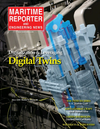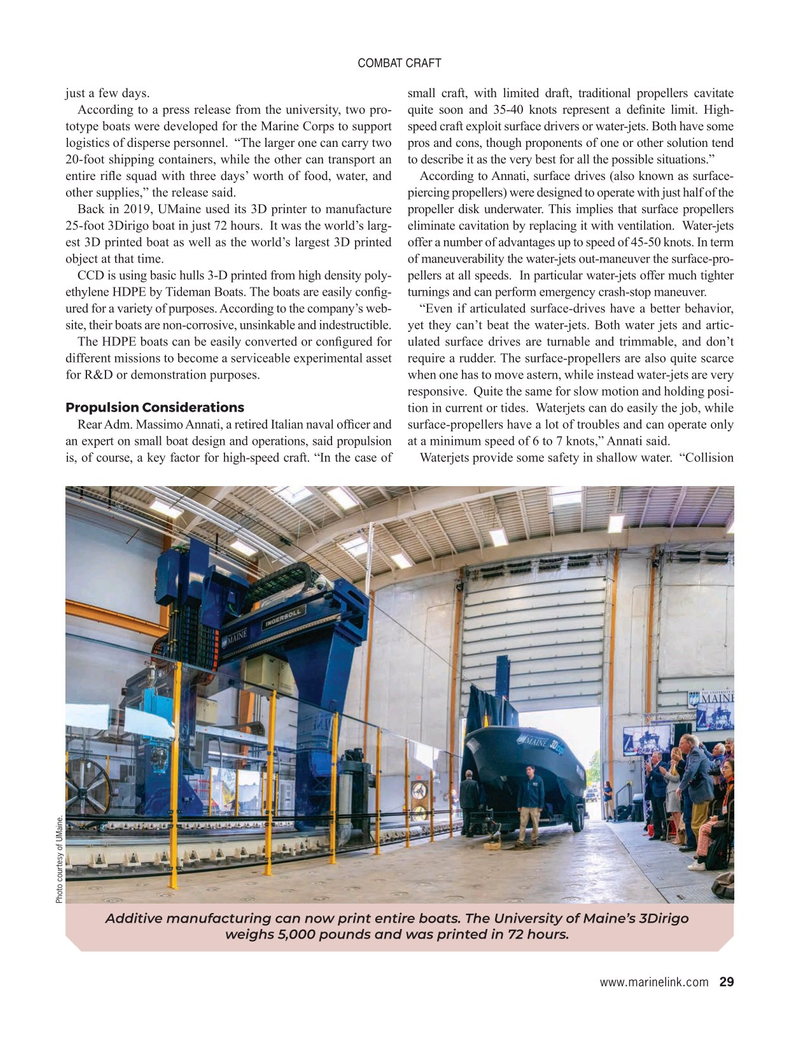
Page 29: of Maritime Reporter Magazine (June 2024)
Read this page in Pdf, Flash or Html5 edition of June 2024 Maritime Reporter Magazine
COMBAT CRAFT just a few days. small craft, with limited draft, traditional propellers cavitate
According to a press release from the university, two pro- quite soon and 35-40 knots represent a de? nite limit. High- totype boats were developed for the Marine Corps to support speed craft exploit surface drivers or water-jets. Both have some logistics of disperse personnel. “The larger one can carry two pros and cons, though proponents of one or other solution tend 20-foot shipping containers, while the other can transport an to describe it as the very best for all the possible situations.” entire ri? e squad with three days’ worth of food, water, and According to Annati, surface drives (also known as surface- other supplies,” the release said. piercing propellers) were designed to operate with just half of the
Back in 2019, UMaine used its 3D printer to manufacture propeller disk underwater. This implies that surface propellers 25-foot 3Dirigo boat in just 72 hours. It was the world’s larg- eliminate cavitation by replacing it with ventilation. Water-jets est 3D printed boat as well as the world’s largest 3D printed offer a number of advantages up to speed of 45-50 knots. In term object at that time. of maneuverability the water-jets out-maneuver the surface-pro-
CCD is using basic hulls 3-D printed from high density poly- pellers at all speeds. In particular water-jets offer much tighter ethylene HDPE by Tideman Boats. The boats are easily con? g- turnings and can perform emergency crash-stop maneuver. ured for a variety of purposes. According to the company’s web- “Even if articulated surface-drives have a better behavior, site, their boats are non-corrosive, unsinkable and indestructible. yet they can’t beat the water-jets. Both water jets and artic-
The HDPE boats can be easily converted or con? gured for ulated surface drives are turnable and trimmable, and don’t different missions to become a serviceable experimental asset require a rudder. The surface-propellers are also quite scarce for R&D or demonstration purposes. when one has to move astern, while instead water-jets are very responsive. Quite the same for slow motion and holding posi-
Propulsion Considerations tion in current or tides. Waterjets can do easily the job, while
Rear Adm. Massimo Annati, a retired Italian naval of? cer and surface-propellers have a lot of troubles and can operate only an expert on small boat design and operations, said propulsion at a minimum speed of 6 to 7 knots,” Annati said.
is, of course, a key factor for high-speed craft. “In the case of Waterjets provide some safety in shallow water. “Collision
Photo courtesy of UMaine.
Additive manufacturing can now print entire boats. The University of Maine’s 3Dirigo weighs 5,000 pounds and was printed in 72 hours. www.marinelink.com 29
MR #6 (18-33).indd 29 6/3/2024 12:09:35 PM

 28
28

 30
30
